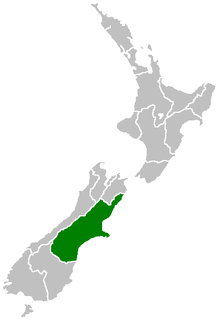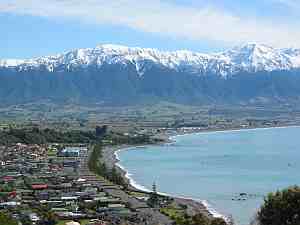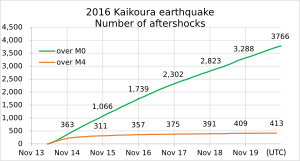
Canterbury is a region of New Zealand, located in the central-eastern South Island. The region covers an area of 44,508 square kilometres (17,185 sq mi), and is home to a population of 628,600.

Hawke's Bay Region is a region of New Zealand on the east coast of the North Island. It is governed by Hawke's Bay Regional Council, which sits in the city of Napier. The region's name derives from Hawke Bay, which was named by Captain James Cook in honour of Admiral Edward Hawke.

Kaikōura is a town on the east coast of the South Island of New Zealand. It is located on State Highway 1, 180 km north of Christchurch. The town has an estimated permanent resident population of 2,210.
Peak ground acceleration (PGA) is equal to the maximum ground acceleration that occurred during earthquake shaking at a location. PGA is equal to the amplitude of the largest absolute acceleration recorded on an accelerogram at a site during a particular earthquake. Earthquake shaking generally occurs in all three directions. Therefore, PGA is often split into the horizontal and vertical components. Horizontal PGAs are generally larger than those in the vertical direction but this is not always true, especially close to large earthquakes. PGA is an important parameter for earthquake engineering, The design basis earthquake ground motion (DBEGM) is often defined in terms of PGA.

Seddon is a small town in Marlborough, New Zealand. It is located 25 kilometres (16 mi) south of Blenheim, close to the mouths of the Awatere and Blind Rivers and the Lake Grassmere salt works. At the 2013 Census, the town had a population of 507 people.

The Alpine Fault is a geological fault that runs almost the entire length of New Zealand's South Island and forms the boundary between the Pacific Plate and the Indo-Australian Plate. The Southern Alps have been uplifted on the fault over the last 12 million years in a series of earthquakes. However, most of the motion on the fault is strike-slip, with the Tasman district and West Coast moving North and Canterbury and Otago moving South. The average slip rates in the fault's central region are about 38mm a year, very fast by global standards. The last major earthquake on the Alpine Fault was in c.1717 AD, the probability of another one occurring within the next 50 years is estimated at about 30 percent.
The Shaky Isles or Shaky Islands is a nickname for New Zealand. At one time this nickname was used in New Zealand itself, though its usage there is now seen as dated; it is still fairly widely used in Australia.

The 1855 Wairarapa earthquake occurred on 23 January at about 9 p.m., affecting much of the Cook Strait area of New Zealand, including Marlborough in the South Island and Wellington and Wairarapa in the North Island. In Wellington, close to the epicenter, shaking lasted for at least 50 seconds. The moment magnitude is estimated to have been in the range 8.2–8.3, the most powerful recorded in New Zealand since systematic European colonisation began in 1840. This earthquake was associated with the largest observed movement on a strike-slip fault, maximum 18 metres (59 ft). It has been suggested that the surface rupture formed by this event helped influence Charles Lyell to link earthquakes with rapid movement on faults.

The 2009 Fiordland earthquake struck the South Island of New Zealand with a magnitude of 7.8 at 9:22 pm (NZST) on 15 July. The earthquake was centred in the remote region of Fiordland, with the epicentre located 150 km (93 mi) west-north-west of Invercargill near Dusky Sound in Fiordland National Park, at a depth of 12 km (7.5 mi). It is among the largest New Zealand earthquakes to occur, including the Culverden/Kaikoura earthquake in 2016 and the 1931 Hawke's Bay earthquake, which both had a magnitude of 7.8.

The 2010 Canterbury earthquake struck the South Island of New Zealand with a moment magnitude of 7.1 at 4:35 am local time on 4 September, and had a maximum perceived intensity of X (Extreme) on the Mercalli intensity scale. Some damaging aftershocks followed the main event, the strongest of which was a magnitude 6.3 shock known as the Christchurch earthquake that occurred nearly six months later on 22 February 2011. Because this aftershock was centred very close to Christchurch, it was much more destructive and resulted in the deaths of 185 people.

A 6.2 earthquake occurred in Christchurch on Tuesday 22 February 2011 at 12:51 p.m. local time. The earthquake struck the Canterbury Region in New Zealand's South Island and was centred 6.7 kilometres (4.2 mi) south-east of the centre of Christchurch, at the time New Zealand's second-most populous city. The earthquake caused widespread damage across Christchurch, killing 185 people in the nation's fifth-deadliest disaster.

The June 2011 Christchurch earthquake was a shallow magnitude 6.0 earthquake that occurred on 13 June 2011 at 14:20 NZST. It was centred at a depth of 7 km (4.3 mi), about 5 km (3 mi) south-east of Christchurch, which had previously been devastated by a magnitude 6.2 MW earthquake in February 2011. The June quake was preceded by a magnitude 5.9 ML tremor that struck the region at a slightly deeper 8.9 km (5.5 mi). The United States Geological Survey reported a magnitude of 6.0 Mw and a depth of 9 km (5.6 mi).

The 2013 Seddon earthquake measured 6.5 on the scale and was centred in New Zealand's Cook Strait, around 20 kilometres (12 mi) east of the town of Seddon in Marlborough. The earthquake struck at 5:09:30 pm on Sunday 21 July 2013 at a depth of 13 kilometres (8 mi), according to Geonet. The United States Geological Survey also measured the quake at 6.5, at a depth of 17 kilometres (11 mi). The quake caused moderate damage in the wider Marlborough area and Wellington, the nation's capital city 55 kilometres (34 mi) north of the epicentre. Only minor injuries were reported. Several aftershocks occurred during 21–29 July.

The 2013 Lake Grassmere earthquake was a magnitude 6.6 earthquake that occurred at 2:31:05 pm (NZST) on Friday 16 August 2013. The epicentre was located about 10 km south-east of Seddon, under Lake Grassmere, with a focal depth of 8 km. The earthquake caused significant land damage in the local area, with landslips blocking roads, including the main highway between Blenheim and Christchurch. Buildings in Seddon were damaged, with some being declared uninhabitable. The earthquake was widely felt in both the North and South Islands of New Zealand.

The 2014 Eketahuna earthquake struck at 3:52 pm on 20 January, centred 15 km east of Eketahuna on the south-east of New Zealand's North Island. It had a maximum perceived intensity of VII (severe) on the Mercalli intensity scale. Originally reported as magnitude 6.6 on the Richter Scale, the earthquake was later downgraded to a magnitude of 6.2. A total of 1112 aftershocks were recorded, ranging between magnitudes 2.0 and 4.9 on the Richter Scale.

The 2016 Te Araroa earthquake was an earthquake measuring 7.1 on the moment magnitude scale that occurred at 04:37:55 NZST on 2 September 2016. The epicentre was located 125 km (78 mi) north-east of Te Araroa off the East Cape of the North Island of New Zealand with a focal depth of 22 km (14 mi). The earthquake was widely felt throughout the North Island and in the upper South Island. There were no reported casualties, and buildings predominantly suffered only a little bit of damage.

The Kekerengu Fault is an active dextral strike-slip fault in the northeastern part of South Island, New Zealand. It is closely associated with the Hope Fault and Jordan Thrust at its south-easternmost edge and likely joins with the Clarence Fault to form the Wairarapa Fault offshore in Cook Strait.

The Canterbury Earthquake Recovery Act 2011 was a New Zealand statute that repealed the Canterbury Earthquake Response and Recovery Act 2010 and set out measures to respond to the impact of the Canterbury earthquakes, and in particular the February 2011 Christchurch earthquake.




















